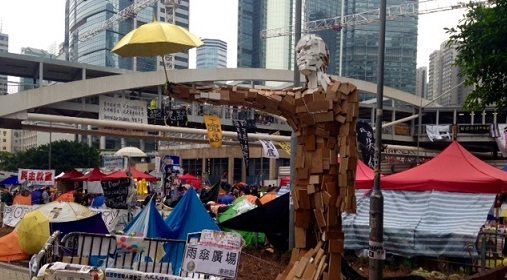By NORMAN SISON
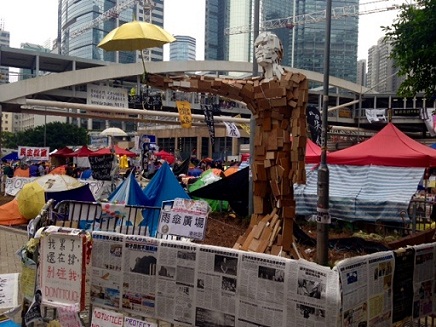
HONG KONG — Anywhere you look, the street has shades of yellow. Yellow ribbons are pinned on the lapels of passersby. They are on fences and lamp posts. Stickers with yellow ribbons printed on them are plastered on the steps of an elevated pedestrian walkway.
But this is not a scene from the 1986 People Power Revolution, the peaceful uprising in which thousands of Filipinos faced down armored vehicles sent to quell a mutiny and eventually toppled the late dictator Ferdinand Marcos. This is downtown Hong Kong.
This is the 2014 Umbrella Movement.
It isn’t exactly a revolt. Unlike the so-called “color revolutions” that sprung up across the world beginning in the late 1980s, however, the pro-democracy protesters in Hong Kong aren’t out to bring down the government.
That is one thing that they want to make crystal clear to Beijing. Although the yellow umbrella is a symbol of their aspiration, the protesters don’t want to give the Chinese government an excuse to crack down on them the way Beijing customarily stamps out dissent.
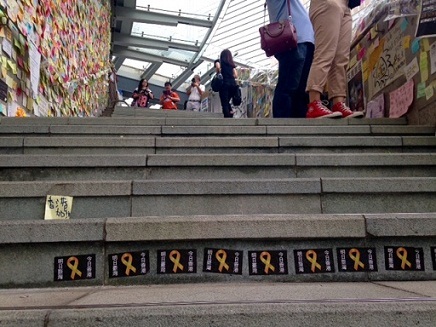
As the Hong Kong protest drags on for nearly two months, it is now a waiting game of which side will blink first. Although the student protesters have cleared Tuesday a road following a court order, they remained determined — and they are aware of how Beijing handles dissent.
“We’ll just go protest somewhere that the injunction doesn’t cover,” a protestor is quoted in a newspaper.
“We are afraid, but we won’t just sit there and do nothing,” says Alfred Wong, a professional poker who volunteers as translator for foreign journalists.
“There is not much that we can achieve, but we won’t let them do what they want so easily,” he adds.
“They have batons and pepper spray. If we use clubs on them, they will pull out their guns with rubber bullets. If we use guns on them, they have tanks.When it comes to violence, they have all the aces, kings and queens. What we have is the moral high ground,” Wong says.
Initially the demonstration was dubbed the “Umbrella Revolution” but some of the protest organizers objected and suggested that it be called the Umbrella Movement. They were concerned that Beijing might perceive the rally as violent.
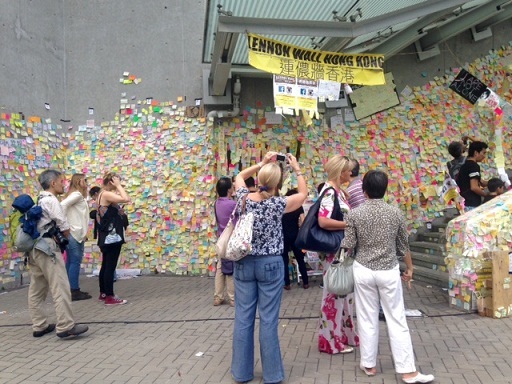
Tents and banners around the main government building have turned the streets into a medieval European battlefield. But compared to pro-democracy protests that usually make it to the world news headlines, the conduct of the Hong Kong rally gives a new definition to the term “civil disobedience.”
As the demonstration is spearheaded by students, the atmosphere has the feeling of a large campus. On quiet days, students spend the time reading their books, fiddling with their mobile phones or typing away on their laptops. There is even a “study corner”, a large tent complete with tables and chairs and the silence of a library.
Hundreds of local and foreign tourists and expatriates working in the former British colony have been descending on the rally and snapping photos.
One wall of the main government building, known as the Lennon Wall Hong Kong, after the late Beatle member and pacifist John Lennon, is plastered with colorful Post-It notes containing messages of support as well as defiance. Of course, there are the usual militant messages.
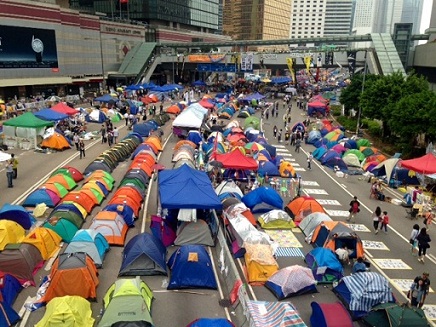 Knowing that the success of their action depends on their solidarity, the protesters have organized themselves into brigades assigned with certain tasks. “There are people volunteering to clean the public toilets. There are people sweeping the street, collecting trash. There are people who donate breakfast meals every morning,” Wong says.
Knowing that the success of their action depends on their solidarity, the protesters have organized themselves into brigades assigned with certain tasks. “There are people volunteering to clean the public toilets. There are people sweeping the street, collecting trash. There are people who donate breakfast meals every morning,” Wong says.
A handful of Filipino activists have joined the rally to show their solidarity. Although Filipino expatriates in Hong Kong have largely stayed away, they could not help being reminded of the 1986 popular uprising that brought down the Marcos dictatorship.
On February 22, 1986, hundreds of thousands of Filipinos blocked the main highway to prevent a column of armored vehicles sent by Marcos from quelling a mutiny holed up at the Camp Crame national police headquarters. Two days later, Marcos and his family fled into exile in Hawaii when the United States withdrew its support for his iron-fisted rule.
English teacher Jay Khilnani, a Briton who splits his time between Hong Kong and the Philippines, where he was raised by Filipina nannies, says the Hong Kong protest has made him appreciate democracy more.
“I think for most Filipinos, democracy is all they know,” observers Khilnani, who has posted a yellow ribbon photo on his Facebook page. “Hong Kong has been continuously prosperous even without democracy. But for the Chinese, they have never known true democracy.”
Democracy in the Philippines may be way ahead but former congresswoman Risa Hontiveros of the Akbayan party points out that the country still has a long way to go. “The Hong Kong protest makes me think that we, too, began a political revolution that we still need to broaden politically and deepen into the economic and social levels, as they will also need to do when they hopefully win a political victory,” she says.
“Coming from a freer country, I feel inspired that other Asian peoples are following our people power footsteps. The ideas of democracy are not exclusively Filipino, and they are obviously considered seditious there in China. But to use another word, subversive, it is what is beneath that can change reality in a deep and lasting way,” Hontiveros muses.
